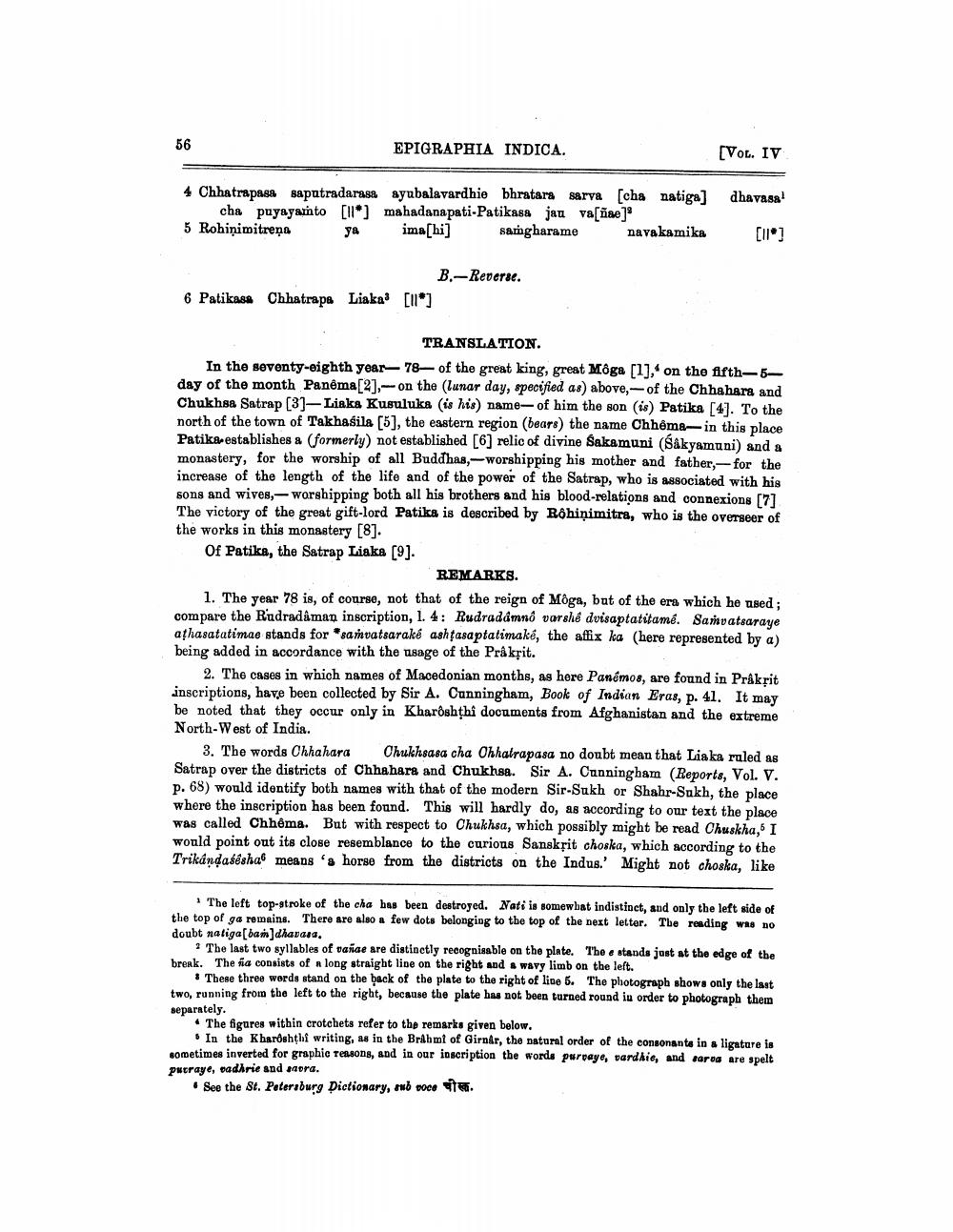________________
EPIGRAPHIA INDICA.
[Vou. IV
dhavasa!
4 Chhatrapasa saputradarasa syubalavardhie bhratars sarva [cha natiga)
cha puyayamto [ll] mahadanapati-Patikass jau va[ae] 5 Rohiņimitrena ya ima[hi] samgharame navakamika
[11]
B.-Reverse. 6 Patikasa Chhatrapa Liaka: [11*]
TRANSLATION. In the seventy-eighth year 78- of the great king, great Môga [1], on the fifth-5day of the month Panema[2], -- on the lunar day, specified as) above,- of the Chhahara and Chukhsa Satrap (31- Liaka kusuluka (is his name-of him the son (is) Patika [4). To the north of the town of Takhasila (5], the eastern region (bears) the name Chhême- in this place Patika-establishes a (formerly) not established [6] relic of divine Sakamuni (sakyamuni) and a monastery, for the worship of all Buddhas,--worshipping his mother and father, for the increase of the length of the life and of the power of the Satrap, who is associated with his sons and wives - worshipping both all his brothers and his blood-relations and connexions [71 The victory of the great gift-lord Patika is described by Rohiņimitra, who is the overseer of the works in this monastery [8]. Of Patika, the Satrap Liaka [9].
REMARKS. 1. The year 78 is, of course, not that of the reign of Môga, but of the era which he used; compare the Rudradaman inscription, 1. 4: Rudraddmnd varsh& dvisaptatitamo. Samvatsaraye athasatatimae stands for samvatsarake ashtasaptatimake, the affix ka (here represented by a) being added in accordance with the usage of the Pråkpit.
2. The cases in which names of Macedonian months, as here Panemos, are found in Prakrit inscriptions, have been collected by Sir A. Cunningham, Book of Indian Eras, p. 41. It may be noted that they occur only in Kharðshțhi documents from Afghanistan and the extreme North-West of India.
3. The words Chhahara Chukhsasa cha Chhatrapasa no doubt mean that Liaka ruled as Satrap over the districts of Chhahara and Chukhsa. Sir A. Cunningham (Reports, Vol. V. p. 68) would identify both names with that of the modern Sir-Sukh or Shahr-Sukh, the place where the inscription has been found. This will hardly do, as according to our text the place was called Chhêma. But with respect to Chukhsa, which possibly might be read Chuskha," I would point out its close resemblance to the curious Sanskrit choska, which according to the Trikándasesha means 's horse from the districts on the Indus. Might not choska, like
The left top-stroke of the cha has been destroyed. Nati is somewhat indistinct, and only the left side of the top of ga remains. There are also a few dots belonging to the top of the next letter. The reading was no doubt natiga ban]dhavara.
The last two syllables of vanae are distinctly recognisable on the plate. The e stands just at the edge of the break. The ha consists of a long straight line on the right and a wavy limb on the left.
These three words stand on the back of the plate to the right of line 5. The photograph shows only the last two, running from the left to the right, because the plate has not been turned round in order to photograph them separately.
The figures within crotchets refer to thp remarks given below.
. In the Kharðshthi writing, as in the Brahmt of Girnar, the natural order of the consonants in a ligature is sometimes inverted for graphic Tessons, and in our inscription the words purvaye, vardkie, and saros are spelt pucraye, eadhrie and sera.
• Soo the St. Petersburg Dictionary, rub pooo .




